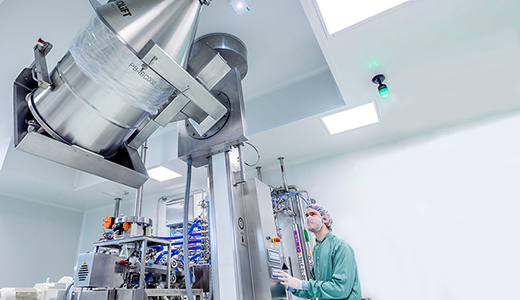Here we answer some common questions about our cell culture media manufacturing sites around the world ― in Pasching, Austria; Logan, Utah in the United States; and Tuas, Singapore.
Question 1: How do you maintain sterility when producing cell culture media?
Answer 1: At sites where we manufacture liquid media, our sterility efforts are a top priority ― for the safety of our employees and the quality of our products. We subject our filling manifolds to stringent steam in place (SIP) protocols and sample extensively to demonstrate a sterility assurance level (SAL) of 10-6. Because we are so rigorous, we do not see significant sterility issues. We do sterility challenges on a regular basis to ensure we minimize the chance for drift. Sterility is not a concern at our Tuas site, because it runs dry powder media only. These nonsterile products are for further manufacturing or research use, not for diagnostic or therapeutic use.
Question 2: Can you detect any drifts over time for concentration of micronutrients and other media components?
Answer 2: We offer testing on custom products. This testing includes trace metal analysis, macro ingredient analysis, and analysis of other quality attributes. We plan to offer this testing on standard products in the future.
Question 3: Can cell culture media be high-temperature short-time (HTST) treated to reduce viral load?
Answer 3: Currently, we have this ability only at our US site in Logan. But we are planning to introduce this process in Pasching.
Question 4: What is the environment in the filling suite for dry powder media (DPM)?
Answer 4: In Pasching we fill DPM in a qualified ISO 8 environment. The filling suite is temperature- and humidity-controlled, as is the whole DPM facility. In Logan, DPM is controlled, not qualified; liquid media is filled in an ISO 7 environment. In Tuas, DPM is temperature- and humidity-controlled but not classified.
Question 5: Do you share raw materials across the three sites where you manufacture cell culture media?
Answer 5: Yes, we have qualified the same materials from the same suppliers to be used at all our sites. Learn more by reading our media powder milling study.
Question 6: How do you establish comparability of DPM from your different sites?
Answer 6: We measured a variety of quality attributes and used relevant equipment for those tests. See Table 1 for the details.
Table 1. Analytical testing performed in DPM comparability studies
| Characteristic |
Influencer |
Assessment |
Method/Reference |
| Physical | • Milling • Raw chemicals |
• Appearance/color • Particle size distribution (PSD) • Bulk density • Angle of repose • Filterability • Moisture (CoA) • Bioburden (CoA) |
• Spectrophotometer • Laser diffraction • SS Pharma washdown volumeter • ASTM C 144-00 • Sartorius Zero-T • Sartorius Mark 3 analyzer • USP 61 |
| Chemical | • Milling • Blending |
• Amino acids • Vitamin • Trace metals • pH (CoA) • Osmolality (CoA) |
• Amino acid analyzer • HPLC • ICP-MS • Potentiometric • Freeze point depression |
| Biological | • Milling • Blending • Raw chemicals |
• Cell growth • Protein production • Protein product quality – aggregates, charge variants, glycan |
• Straight batch, fed batch • IgG production • UPLC |
* CoA is certificate of analysis; ICP-MS is inductively coupled plasma-mass spectrometry.
Question 7: When filling the final container with DPM, is the powder agitated?
Answer 7: It is agitated, but not continuously. The blender starts every 30 min for one ‘round’ to prevent ‘sitting’ of the powder. The blender can also be triggered manually if bridging occurs.
Question 8: Do you make liquid media and buffers in the same tank?
Answer 8: Yes. Between batches, we follow validated cleaning protocols as outlined in the media validation guide.
Question 9: How do you handle the animal-derived components?
Answer 9: Pasching and Tuas are completely animal-derived component-free (ADCF) and do not handle animal products. In Logan, we do ADCF and animal-derived manufacturing in a single-use processing area. We can ensure that there is no product contact or contamination, if a customer requests this confirmation.
Question 10: Which film platform do you use for HyClone™ process liquids and buffers?
Answer 10: We currently use the CX5-14 film for the standard bags of our process buffers and liquids. That said, we approach the bags as an open architecture. Thus, we have capabilities with other film platforms and are consistently evaluating to broaden the design space
Learn more about our solutions for cell culture ― media and feeds, cell culture sera, buffers and process liquids, and microcarriers.
